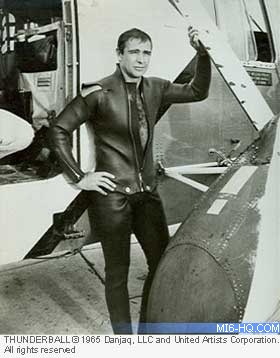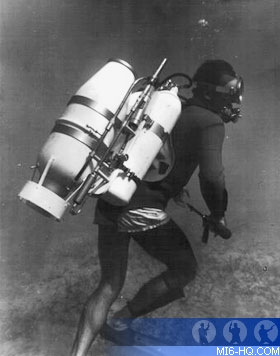 |
| |
MI6 caught up with underwater engineer Jordan Klein
to talk about his early career and his first brush
with James Bond on "Thunderball"...
 Jordan
Klein Interview (2) Jordan
Klein Interview (2)
|
|
Jordan Klein Interview (1)
7th January 2009
How long ago did you learn to dive and how did you become interested in subsurface activities?
I was in the Navy during World War II, I went to diving school. It was hard-hat diving at the time, and I learned one thing about it, I didn't want to be a hard hat diver. After the war, the Aqualung was getting popular in Florida. I opened a dive shop on Biscayne Boulevard in Miami, "Underwater Sports", and sold Aqualungs and other SCUBA gear. I also had a dive boat - I think it was probably one of the first, if not the first, dive boat on the east coast of the United States. At any rate, that's how it all started.
How did you get involved in filmmaking and was diving a natural segue to this or vice-versa?
Even when I was a teenager before the war, we built our own breathing equipment. We used five gallon steel milk cans for our diving helmet, soldering on a port, made fins out of tennis shoes and cut out pieces of tire and riveted it onto the bottom of the shoes; cut a donut out of an inner-tube and made a little copper ring that would hold a piece of glass in the front and put that on for a face-mask.
|
|
After the war I brought a boat from the University of Miami Marine Laboratory and called it "Arbalete", and used it for taking diving trips off the Florida coast as well as through the Bahamas. The dive trips were very lucrative, so I brought an 80 foot PT boat surplus for $25,000. I had a lot of well-known people like Cary Grant, William Randolph Hearst Jr, and Errol Flynn on the boat. I realised that it would be tough to earn any serious money running a dive boat for the rest of my life.
I started manufacturing underwater photographic equipment and built MAKO housings for many still cameras and Bolex 16mm cameras. I patented a camera called the MAKO SHARK and sold it for $19.95. Rexall Drug Stores sold about 55,000 of them. That's what got me going financially so I could start designing and manufacturing the housings for theatrical application, mainly for Arri 35mm motion picture production cameras.
|
Ivan Tors was in Miami at the time, having built a studio there. He offered me the opportunity to shoot the "Flipper" TV series - and that was the beginning for me. I ended up in the IA and started filming because there wasn't anyone else, only me and a great cameraman named Lamar Boren, who was the underwater DP on "Thunderball" and Ricou Browning was the underwater director on "Flipper" and "Thunderball".
You are credited as an underwater engineer on "Thunderball" - what does that role entail?
Spending time with Ken Adam and Peter Murton - both of whom
were great to work with and extremely talented. I helped modify
the designs so that they could be built and function underwater.
The first designs were not practical for the load imposed underwater
so I offered changes to retain the designs as much as possible
and function underwater. I
built the sleds and Bomb Carrier in three weeks of day and night
work with one other person. In fact I still have one of the sleds
hanging from the roof in my hangar. I have the plaster model. Someone
from the art department sent me what they wanted by way of a balsa
wood. I sent them back a plaster design showing what the bomb carrier
design should look like. I still have that and it's pretty neat.
It's only about 16 to 18 inches long and approximately 12 inches
wide and weighs over 15 pounds.
I was to shoot second camera
on "Thunderball", what happened was that I built
the sleds and bomb carrier and arranged for it all to go
on a support boat. They rented a 60 foot 'shrimper' with
a round bottom. When we picked up the bomb carrier, which
was very heavy, we almost rolled over. In the process we
were forced to drop the Bomb Carrier 20 feet from the water
which resulted in an all night repair job.
I got another barge that everything could go on. I made sure the batteries were charged, any damage was repaired and that the units were all active. Then we started filming with the Bomb Carrier, but every time someone ran it they'd smash it up. So I'd have to spend the night fixing it again. Ricou Browning, the director said, "You get in that thing and run it." So that's what happened, I piloted the Bomb Carrier whenever it was on camera.
"I think Thunderball is probably the greatest underwater production so far!"
|
|

|
And then déjà vu all over again
on "Never Say Never Again". I
did the exact same thing. I built all the hardware and they smashed
it all up. We almost got thrown out of the park in Freeport Bahamas
when the pilot hit some stalagmites and stalactites in
a cave and broke them. The whole world came to an end as far
as the ecologically minded people were concerned. So they told
me, "You run the thing!" So the same thing happened,
I ended up not shooting many scenes, but I did shoot many of
the fight scenes in NSNA.
How long was the shoot for the underwater fight?
I think we did it in four days - with a lot practice.
We had a big barge that we worked off of with a lot of walkthroughs
in place of swim-through. The other thing was that Lamar was shooting
and he had an old Akeley camera, I had an Arriflex (400 foot loads
- that's three minutes of film).
 Above: A stunt double for Sean Connery dons Jordan Klein's
jet-pack for filming the climatic underwater battle.
Above: A stunt double for Sean Connery dons Jordan Klein's
jet-pack for filming the climatic underwater battle. |
|
So by the time we got
everything ready, they were out of air. One diver has
air, another doesn't. One diver is half way up to the
surface and the other diver is lying on the bottom. So,
Ricou had everyone walk it through over and over on the
barge before we even got in the water. We went
through it underwater a number of times shooting "insert
shots" then when it looked like it was coming together
the "master" was shot
Can you describe how the concept for
Sean Connery's underwater jet-pack came about and at
what stage of the project did you get involved?
I remember that I said to David Middlemas, "What
is he going to have that was like the briefcase from 'From
Russia With Love' and the rest of that stuff?" I do remember
having this discussion with David and he said that they were
going to shoot M's headquarters on Monday morning. He
said that if I could build it and have it there for Monday
morning, they would pay what I was asking, otherwise, they
didn't want it. So I jumped on a plane on Friday afternoon
and worked steady all weekend and getting back Monday, at
8.45 and gave it to them.
|
I'm pretty sure the first one I did was powered
and everything worked. I don't have one, but I wish I had kept
one of them. I built three in all and two went to the studio
in the UK, straight away. I'm sure the one I delivered to Nassau
had everything working, because it had to operate for the scenes.
In what way has underwater filmmaking technology changed in the time you've been working in the industry - what have been some of the greatest achievements?
In the old days I've had my camera fill almost all the way
up with salt water and that night, by two o'clock in the morning,
the camera is back running. As long as the optics hadn't gotten
screwed up, I was a happy camper; I knew that I could get it to
run the next morning. But as far as the direction things are going
now, after years and years of my arguing, "It's not yet time,
it's not yet time to go digital." It's
obvious now that this is the time we're going digital and film
is on its way out. There are big plusses with what you can do with
the medium and there are the major negatives. It's just not reliable.
I don't mean that the design isn't reliable, I mean that if you
are working around water, that reduces the reliability tremendously.
The other thing that's happened is that we've developed a stabilization device, and have been using it for a couple of years, It's next to impossible to stabilize on a boat so we've come up with a piece of equipment called a MAKOHEAD. It goes on a tripod and you put the camera on top of it and it'll maintain horizon on a rolling/pitching boat. We just had one with the Bond picture shooting in Panama - we rent them, we don't sell them. It's being used all over the world.
Related Articles
 Jordan
Klein Interview (2)
Jordan
Klein Interview (2)
 Thunderball Coverage
Thunderball Coverage
Many thanks to Jordan Klein. All pictures, unless
otherwise stated, courtesy Jordan Klein.